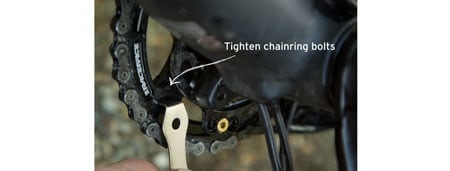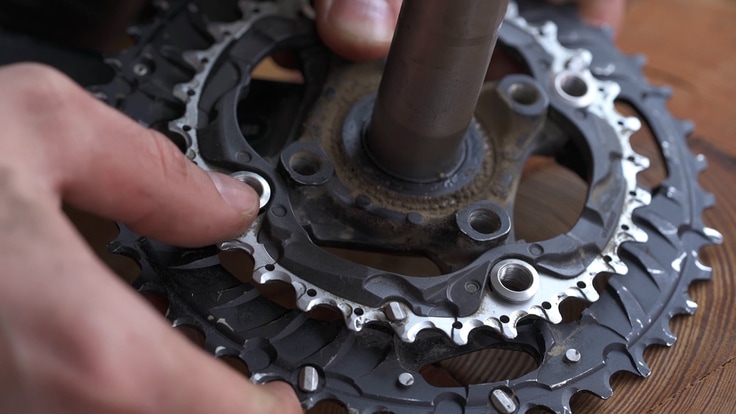A key component of your bike's drivetrain, your chainrings can become worn over time. They'll start to look like shark fins and you'll notice wear in the opposite direction of chain travel.
With extreme wear, your chain can slip from one ring to another or you may experience "chain suck," where the chain doesn't release properly from the teeth on the chainrings, and the chain can get jammed.
These are all signs that it's time to replace the chainrings.
Depending on your setup, you may or may not need to remove the entire crank to remove your chainrings. This article focuses on how to change your chainrings if you can do so without removing the crank.
Shop REI's selection of bike chainrings.
Video: How to Replace a Chainring
Tools and Parts for Changing Chainrings
Identifying your chainring type: Buying new chainrings and changing them out can be tricky. Chainrings have a variety of bolt patterns depending on if you have a traditional or compact drivetrain, and if you're buying for a road or mountain bike.
Some "direct mount" chainrings have no exterior bolts; instead, the chainring mounts directly to the crankarm and is held on by a type of lockring. Some bikes might even have chainrings that are integrated with the crankarm, and you will need to replace the entire unit.
When replacing your chainrings, what you buy will be determined by how many bolts attach your chainrings to your bike, combined with a mathematical equation based on a measurement called the bolt circle diameter (BCD). Have your bike mechanic help you determine your BCD so you can choose the correct parts.
Tools: Several bolts are used to secure your bike's chainrings to the crankset, and different nut/bolt combinations will require different tools.
You will almost always need a chainring nut wrench, which is compatible with a type of bolt that has a slotted channel running through the center of the nut, called a chainring nut. You will also need either a hex (Allen) wrench or a torx wrench.

Removing Bike Chainrings
First identify the correct wrenches (chainring nut wrench, hex or torx wrench) compatible with the chainring nut on the outside of the chainring and the bolt on the back side. Once your wrenches are in place, turn the nut on the front to loosen it while keeping the bolt in the back secured in place. Once fully removed, save the nuts and bolts to use with your new chainrings. Next, slip the chainrings over your crankarm.
(If you find that you can't do this step, you'll need to remove the entire crank which requires additional tools and techniques not covered in this article.)
Installing Bike Chainrings
To install new chainrings, you essentially reverse the removal process, starting with the largest ring.
Slide the chainring over your crankarm. The chainring brand name should be facing out (away from the bike) so that the ramped edges of the chainring are facing in (toward the bike). (The "ramps" help guide your chain when moving to the next chainring.)
Large chainrings usually have a pin or tab designed to prevent your chain from jamming between the chainring and crankarm. Position the chainring so that the pin is protruding away from the body of the bike and sits behind the crankarm.
Apply grease to the bolts, then replace the bolts and nuts with the same tools you used to remove them, but don't tighten them all the way. Once all bolts and nuts are installed, tighten each bolt a quarter turn, moving around the ring until all are tight. Then check each with a torque wrench, tightening to the manufacturer's recommendation.

Place your chain back on a chainring and pedal the bike with your hand to make sure everything works properly. If you've changed the size of your outer chainring, you may need to adjust the height of your front derailleur.
Shop REI's selection of bike chainrings.
Bike Chainring Maintenance
Depending on how much you ride, you may want to thoroughly clean your chainrings at least a couple times per year. See our article, How to Clean a Bike, for more information.
If you live near the beach where sand can get into your drivetrain or if you live in a wet environment where rain routinely flushes away your chain lube, making your chain rusty, keep a closer eye on the condition of your entire drivetrain.
Replacing your chain proactively can often postpone the need to replace your chainrings, so be sure to read our article, How to Change Your Bike Chain.
